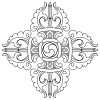Phowa
| Part of a series on |
| Vajrayana Buddhism |
|---|
 |
|
Traditions Historical traditions:
New branches:
|
|
History |
|
Pursuit |
|
Practices |
|
Festivals |
|
Ordination and transmission |
| Vajrayana Buddhism portal |
Phowa (Tibetan: འཕོ་བ་; Wylie: 'pho ba; also spelled Powa or Poa phonetically; Sanskrit: saṃkrānti) is a Vajrayāna Buddhist meditation practice. It may be described as "the practice of conscious dying", "transference of consciousness at the time of death", "mindstream transference", or “enlightenment without meditation” (Wylie: ma-sgom sangs-rgyas ).
Application of Phowa
The method can be applied at the moment of death to, according to Vajrayāna Buddhist belief, transfer one's consciousness through the top of the head directly into a Buddha-field of one’s choice. By so doing, one bypasses some of the typical experiences that are said to occur after death.[1] Example destinations are Sukhāvatī, Abhirati, Ghanavyūha, Aṭakāvatī, Mount Potala, the Copper-Colored Mountain (Wylie: Zangs-mdog dpal-ri ), and Tuṣita;[2] the most popular in Chinese, Japanese and Tibetan Buddhism is Sukhavati. Phowa is also performed by specialists (Wylie: ’pho-’debs bla-ma ) on the behalf of the deceased, as a post-mortem ritual. [3]
Mark of Phowa practice
The mark of a successful Phowa practice is a small drop of blood directly from the center of the vertex. To demonstrate a successful practice traditionally a Kusha-grass was pushed into the small opening created in the fontanel.[4][5]
Lineages
The main lineage of phowa is one of the Six yogas of Naropa, although other transmissions also exist. The chöd subsumes within its auspices aspects of phowa sadhana.[6]
The Kagyu phowa lineage is from the Six yogas of Naropa. Nāropa received it from the Indian mahāsiddha Tilopa and later passed it to his Tibetan disciple Marpa.
Nāropa’s teachings describe a second method of ’pho-ba that entails the transference of one’s consciousness to another body (Wylie: ’pho-ba grong-’jug ). Milarepa’s query regarding these teachings forced Marpa to search for explanatory treatises on the subject among his Indian manuscripts, and, having found none, to return to India to obtain more scriptures.[7]
The Drikung Kagyu school of Tibetan Buddhism is known for their phowa teachings. A major pilgrimage and cultural celebration is known in the Tibetan world as the Great Drikung Phowa (Wylie: ’Bri-gung ’pho-ba chen-mo ). This festival was traditionally held once in every twelve-year calendrical cycle, and its last observance took place in August 1992 in gTer-sgrom, Central Tibet, after a hiatus of 36 years due to a ban enforced by the Chinese authorities.[8] Choeje Ayang Rinpoche from Eastern Tibet belongs to the Drikung school and is an authority on Buddhist afterlife rituals; he gives teachings and initiations to the practice of phowa annually in Bodh Gaya, India.[9]
Some lineages of phowa include a rite of incision, or opening of the sahasrara at the cranial zenith, to assist with transferral.[10]
In Dzogchen
Shugchang, et al., in an exegesis of the Zhitro, discuss phowa in Dzogchen:
Phowa has many different meanings; in Tibetan it means "transferring consciousness." The highest form is known as the phowa of the dharmakaya which is meditation on the great perfection. When you do Dzogchen meditation, there's no need to transfer anything, because there's nothing to transfer, no place to transfer it, nor anyone to do it. That's the highest, and greatest phowa practice.[11]
See also
Literature
- Chagud Khadro : Phowa-Commentary - Instructions for the practice of Consciousness Transference, Pilgrims Publishing, 2003, ISBN 8177690973
References
- ↑ Lingtrul Rinpoche. Teachings on Phowa
- ↑ Karma Chagmé 2000, Naked Awareness, p.196
- ↑ Halkias, T. Georgios. 2013. Luminous Bliss: A Religious History of Pure Land Literature in Tibet, chapter 5.
- ↑ Website with phowa-skulls
- ↑ Lu Kuan Yü, Secrets of Chinese meditation - with detailed chapter of the exercise ]
- ↑ Dudjom Lingpa, via Chagdud Tulku. 1985. Tröma: Treasury of Dharmata. (Chöd Text). Cottage Grove: Padma Publishing. p. 12, 17, 24, 29, 38, 48.
- ↑ Douglas, Nik and Meryl White. 1976. Karmapa: The Black Hat Lama of Tibet. London: Luzac. p. 15.
- ↑ Kapstein, Matthew. 1998. “A Pilgrimage of Rebirth Reborn: the 1992 Celebration of the Drigung Powa Chenmo”. In Buddhism in Contemporary Tibet, ed. M. Goldstein and M. Kapstein, Delhi: Motilal Banarsidass, 95-119.
- ↑ http://ayangrinpoche.org/an-introduction-to-phowa/
- ↑ The Secrets of Chinese Meditation ; Lu Kuan Yu , page 249
- ↑ Shugchang, Padma (editor); Sherab, Khenchen Palden & Dongyal, Khenpo Tse Wang (2000). A Modern Commentary on Karma Lingpa's Zhi-Khro: teachings on the peaceful and wrathful deities. Padma Gochen Ling. Source: (accessed: December 27, 2007)